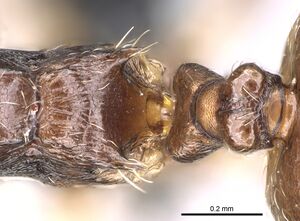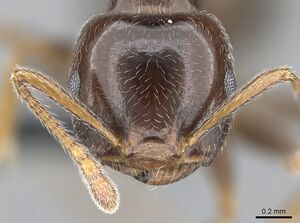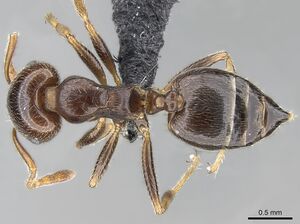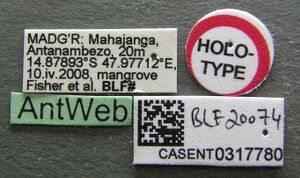Crematogaster ramamy
| Crematogaster ramamy | |
|---|---|

| |
| Scientific classification | |
| Kingdom: | Animalia |
| Phylum: | Arthropoda |
| Class: | Insecta |
| Order: | Hymenoptera |
| Family: | Formicidae |
| Subfamily: | Myrmicinae |
| Tribe: | Crematogastrini |
| Genus: | Crematogaster |
| Species: | C. ramamy |
| Binomial name | |
| Crematogaster ramamy Blaimer, 2013 | |
Crematogaster ramamy is a species found at low elevations in dry forest, savannah and sometimes mangrove habitats in western and northwestern Madagascar. The species further has a disjunct, isolated population at higher altitude in the transitional dry forest of RS Ambohitantely (1410 m). Crematogaster ramamy usually co-occurs with Crematogaster dentata, Crematogaster maina and Crematogaster lobata, and at some locations also with Crematogaster tricolor, Crematogaster mafybe and Crematogaster sewellii. Generally it has been collected nesting arboreally in dead twigs above the ground, and is attracted to arboreal fish baits as strongly during the day as at night.
Identification
Blaimer and Fisher (2013) - Crematogaster degeeri assemblage. Within the C. degeeri-assemblage, this species is uniquely recognized by a transverse impression across the propodeum, although this character can be faint and difficult to see. Additional useful distinguishing characters are abundant erect pilosity on the promesonotum ( > eight setae) and carinulate or costulate sculpture on the pronotum. In its distribution range C. ramamy can only be confused with Crematogaster dentata, however, the species has longer propodeal spines than the latter (C. dentata: SPI 0.01-0.10; C. ramamy: SPI 0.07-0.12), and costulate sculpture on the pronotum (aciculate - reticulate in C. dentata).
Keys including this Species
Distribution
Latitudinal Distribution Pattern
Latitudinal Range: -12.917077° to -24.3505°.
| North Temperate |
North Subtropical |
Tropical | South Subtropical |
South Temperate |
- Source: AntMaps
Distribution based on Regional Taxon Lists
Malagasy Region: Madagascar (type locality).
Distribution based on AntMaps
Distribution based on AntWeb specimens
Check data from AntWeb
Countries Occupied
| Number of countries occupied by this species based on AntWiki Regional Taxon Lists. In general, fewer countries occupied indicates a narrower range, while more countries indicates a more widespread species. |

|
Estimated Abundance
| Relative abundance based on number of AntMaps records per species (this species within the purple bar). Fewer records (to the left) indicates a less abundant/encountered species while more records (to the right) indicates more abundant/encountered species. |

|
Biology
Castes
Known only from the worker caste.
Images from AntWeb
    
| |
| Worker. Specimen code casent0317764. Photographer Estella Ortega, uploaded by California Academy of Sciences. | Owned by CAS, San Francisco, CA, USA. |
   
| |
| Holotype of Crematogaster ramamy. Worker. Specimen code casent0317780. Photographer Estella Ortega, uploaded by California Academy of Sciences. | Owned by CAS, San Francisco, CA, USA. |
Nomenclature
The following information is derived from Barry Bolton's Online Catalogue of the Ants of the World.
- ramamy. Crematogaster ramamy Blaimer, in Blaimer & Fisher, 2013b: 48, fig. 19 (w.) MADAGASCAR.
- Type-material: holotype worker, 4 paratype workers.
- Type-locality: holotype Madagascar: Mahajanga, Antanambezo, 20 m., -14.87893°S, 47.97712°E, 20.iv.2008, BLF20074, mangrove (B.L. Fisher, et al.); paratypes with same data.
- Type-depositories: CASC (holotype); MCZC, MHNG, SAMC, UCDC (paratypes).
- Distribution: Madagascar.
Unless otherwise noted the text for the remainder of this section is reported from the publication that includes the original description.
Description
Worker
(n = 16) [holotype] HW 0.75-1.04 [0.95]; HL 0.71-0.94 [0.90]; EL 0.16-0.22 [0.17]; SL 0.62-0.82 [0.72]; WL 0.86-1.12 [1.03]; SPL 0.06-0.12 [0.09]; PTH 0.12-0.22 [0.18]; PTL 0.22-0.31 [0.27]; PTW 0.22- 0.33 [0.28]; PPL 0.13-0.19 [0.17]; PPW 0.20-0.33 [0.27]; LHT 0.65-0.82 [0.73]; CI 1.05-1.13 [1.05]; OI 0.19-0.24 [0.19]; SI 0.75-0.87 [0.80]; SPI 0.07-0.12 [0.09]; PTHI 0.55-0.76 [0.66]; PTWI 0.95-1.14 [1.04]; PPI 1.36-1.80 [1.58]; LBI 1.27-1.41 [1.40].
Small to medium size (HW 0.75-1.04, WL 0.86-1.12). Masticatory margin of mandibles with four teeth; head shape quadrate, as long or slightly longer than wide (CI 1.05-1.13); posterior margin of head in full-face view laterally rounded or subangular; occipital carinae usually distinct; antennal scapes reaching or surpassing head margin; midline of eyes situated slightly above midline of head in full-face view; eyes moderately large (OI 0.19-0.24) and protruding. Pronotum laterally angular; promesonotal suture indistinct; mesonotum more or less forming one plane with pronotum, but often the two separated by distinct variation in sculpture (see below); mesonotum usually without posterior face; laterally mesonotum angular to carinate, not distinctly set off from propodeum; metanotal groove shallow, laterally constricted; propodeal spines short, spiniform (SPI 0.07-0.12), usually curved downwards; dorsal face of propodeum short but distinct; posterior face of propodeum gently sloping, often with a transverse groove; petiole in dorsal view oval and fairly slender, dorsolaterally rounded, without posterolateral tubercules or denticles; subpetiolar process variable, usually a small dent; postpetiole distinctly bilobed, with a narrow median impression; subpostpetiolar process absent. Head sculpture aciculate to reticulate; pronotum usually dorsally carinulate and contrasting abruptly with a shiny to aciculate mesonotum; mesopleuron areolate, metapleuron mostly carinulate; dorsal face of propodeum carinulate or reticulate; otherwise sculpture reticulate; face usually with six to ten erect, longer setae, and regular appressed to decumbent pubescence; erect pilosity on promesonotum usually abundant, with > eight long setae; otherwise promesonotum dorsally with regular appressed to subdecumbent pubescence; petiole and postpetiole usually with a pair of short erect, setae posterolaterally, and shorter suberect, decumbent or appressed pubescence; abdominal tergites and sternites four to seven usually with abundant, short, erect pilosity, and abundant appressed to decumbent pubescence throughout. Color reddish brown to dark brown.
Type Material
Holotype Worker: pinned, CASENT0317780, BLF20074, on low vegetation [imaged on AntWeb]; original locality label: MADG’R: Mahajanga: Antanambezo, 20 m -14.87893º S, 47.97712º E, 20 Apr. 2008, mangrove, Fisher et al., BLF#; deposited at California Academy of Sciences. Paratypes 4 workers, pinned, same collection and locality data as holotype. #1: CASENT0317781, deposited at South African Museum. #2: CASENT0317782, deposited at Musee d'Histoire Naturelle Genève. #3: CASENT0317783, deposited at Museum of Comparative Zoology. #4: CASENT0317784, deposited at University of California, Davis. MADAGASCAR: Mahajanga: Antanambezo: -14.87893, 47.97712, 20 m, mangrove.
Etymology
Crematogaster ramamy is named after a Malagasy friend and research assistant, Maminiaina “Mamy” Rajaonarivo, in appreciation of support over several years. The name is treated as a noun in apposition.
References
- Blaimer, B.B., Fisher, B.L. 2013. Taxonomy of the Crematogaster degeeri-species-assemblage in the Malagasy region (Hymenoptera: Formicidae). European Journal of Taxonomy 51: 1-64 (doi:10.5852/ejt.2013.51).
References based on Global Ant Biodiversity Informatics
- Blaimer B. B., and B. L. Fisher. 2013. Taxonomy of the Crematogaster degeeri-species-assemblage in the Malagasy region (Hymenoptera: Formicidae). European Journal of Taxonomy 51: 1-64.
- Ravelomanana A., and B. L. Fisher. 2013. Diversity of ants in burned and unburned grassland , and dry deciduous forest in the Beanka Reserve, Melaky Region, western Madagascar. Malagasy Nature 7: 171-183.

